
TEMPERATURE SCANNERS | 5.5 MIN READ
As COVID-19 continues to impact business operations, many companies are wondering how to minimize its spread and safely keep their doors open. Infrared temperature scanners offer businesses a solution that, when used in conjunction with current FDA policy, can be effective at detecting individuals who may be at risk for being infected with COVID-19. Keep reading to learn what a temperature scanner is, how it works, and other commonly asked questions.
Not enough time? Jump to:
Hybrid Option: Temperature Scanning Kiosk
Can They Prevent the Spread of Infectious Conditions?
How Much Does a Temperature Scanner Cost?
How Can Temperature Scanners Be Integrated Into a Business?
What Are They?
Temperature scanners are synonymous with thermometers. They are devices used to measure an individual's temperature. There are four basic types: oral, temporal (forehead), tympanic (ear), and thermal cameras. Additionally, other hybrid options like temperature scanning kiosks exist.
A temperature reading may vary based on what type of scanner you use and how you use it. For instance, if you insert an oral thermometer into an individual's mouth to take their temperature, a reading may be different than if you used the same thermometer but took a reading from the individual's armpit.
While the first medical thermometer was invented in 1867 and typically used mercury or alcohol to take a reading, technological advancements and a decline in mercury-based thermometers due to health concerns mean that most modern thermometers now use thermoresistors or infrared technology.
Thermoresistors are used in most electronic thermometers such as oral ones. These types of thermometers work by changing resistance based on changes in temperature. A computer inside the thermometer or other circuit measures the resistance and converts it to a temperature reading.
Other temperature scanners such as thermal cameras use infrared scanning technology to assess an individual for fever-like temperatures. These types of thermometers focus infrared light at an object, and then translates the amount of energy or radiation coming from its surface into a reading.
How Accurate are They?
We've ranked the different types of temperature scanners below in order from most accurate to least accurate. In general, a good rule of thumb is the less physically invasive a thermometer is, the less accurate it is.
1. Oral Thermometers
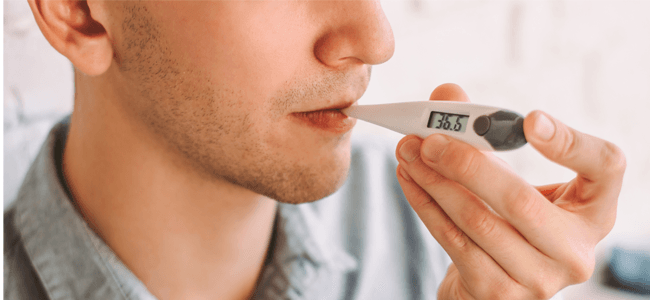 Oral thermometers, which traditionally are used in households, give the most accurate readings. While these thermometers can also be inserted rectally or into one's armpit, use of the armpit decreases the accuracy of the thermometer.
Oral thermometers, which traditionally are used in households, give the most accurate readings. While these thermometers can also be inserted rectally or into one's armpit, use of the armpit decreases the accuracy of the thermometer.
Oral thermometers inserted rectally are typically the most effective at checking a young child in particular's temperature. For older children and adults, oral thermometers are the most accurate option.
Keep in mind, however, that for mass screening purposes, these thermometers can be cumbersome, seeing as they require more thorough disinfection before reuse.
2. Temporal (Forehead) Scanners
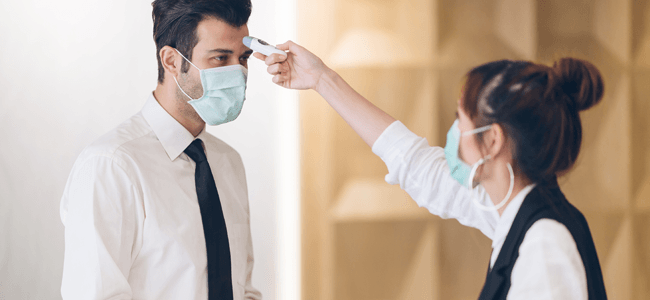
According to a study published in the National Library of Medicine's archives, temporal thermometers, which take readings by scanning the temporal artery on the forehead, are the best alternative to oral/rectal digital thermometers.
Since temporal scanners tend to use infrared technology, they can also be used to take a person’s temperature from a greater distance, which makes them a good candidate for use in mass screening.
Keep in mind, however, that distance from the scanner can affect its accuracy. The farther one gets from the scanner, the more the reading will vary since the light has to travel farther to scan an individual.
3. Tympanic (Ear) Thermometers
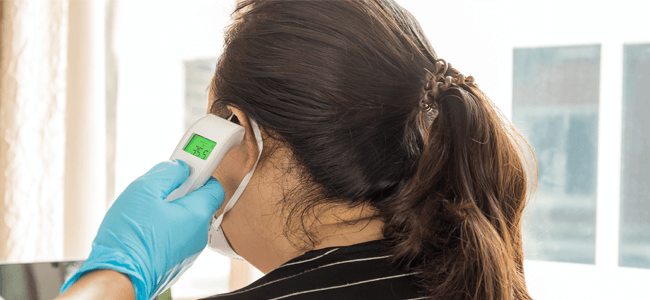
Tympanic thermometers, which take a temperature from the tympanic membrane inside your ear canal, are the third best type of scanner.
These scanners are good for taking individual readings that are less invasive than oral readings. Keep in mind, however, that according to Mayo Clinic, those will wax buildup or small, curved ear canals may cause the readings to vary.
4. Thermal Cameras
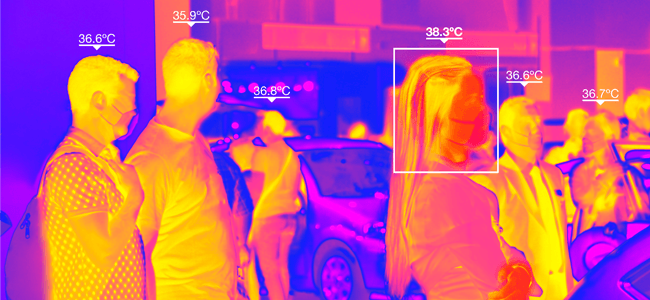
Like temporal scanners, thermal cameras use infrared scanning technology to obtain a reading. However, unlike temporal scanners, which use only the temporal artery to obtain a reading, thermal cameras scan an individual's entire body.
Thermal cameras are typically used to mass-screen large groups of individuals at one time. For instance, a concert venue could set up one of these cameras in the front lobby and scan hundreds of people at once as they stream in through the front doors.
However, according to Ethan Ace from IPVM, a surveillance industry research group that has been testing the fever camera systems, when these cameras mass-scan large groups of people at one time, they can tend to average temperatures out.
This can make readings ineffective as opposed to temporal (forehead) scanners which take individual readings from a closer distance. An individual's distance from the camera can also make the reading vary.
5. Smartphone Thermometers

While these types of thermometers are inaccurate and not widely accepted by the medical community, they are technically another type of thermometer, so therefore we included it on this list.
While phone makers like Samsung and Motorola have released phones that have built-in thermometers, these are not user-friendly and require a variety of conditions to obtain a semi-accurate reading.
To keep readings from being inaccurate, an individual must not touch the phone and the phone must also be kept in an area that isn't too hot or cold, among other variables.
Some smartphone apps also promise accurate temperature readings, however, be wary. While there is a thermometer inside your phone, it is for measuring battery temperature to keep your phone from overheating. It is extremely difficult for this internal thermometer to register temperatures external to a phone.
Hybrid Option: Temperature Scanning Kiosk
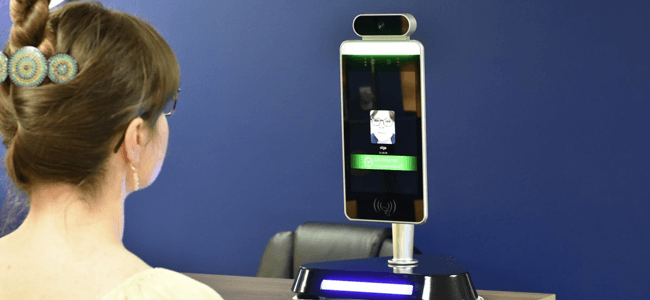
There is one option, a temperature scanning kiosk, that combines the accuracy of the temporal scanner with the mass-screening abilities of the thermal camera.
These kiosks use similar infrared scanning technology to thermal cameras, but instead of scanning an individual's entire body, only their forehead is scanned. Since the temporal artery in the forehead is a good base for temperature taking, these kiosks function, in some ways, like a temporal scanner.
However, a temperature scanning kiosk can be more accurate than a thermal camera based on how you use it. While thermal cameras are typically positioned high on a wall to scan hundreds of people at the same time from far away, a temperature scanning kiosk only scans one person at a time, and requires that person to stand about 2 feet away.
Up-close individual scans allow for less variability in readings as opposed to thermal cameras. Additionally, because these kiosks are non-contact, they minimize the contact that employees have with visitors compared to
hand-held temperature scanners.
To use one of these kiosks, an individual must step within the target range, which is usually about 1-3 feet. Using infrared technology, the kiosk will scan the individual’s forehead and take their temperature.
If an individual has a temperature higher than the allowed threshold, they can be pulled aside for additional screening.
With some brands, user profiles can be created to recognize repeat visitors and historically track their temperatures. This is useful in the event of having to contact trace an individual who becomes sick with a contagious condition.
RELATED: What is a Temperature Scanning Kiosk?
Can They Prevent the Spread of Infectious Conditions?
While using temperature scanners cannot fully prevent the spread of infectious conditions, in the case of an organization, they can be used to identify individuals who should be pulled aside for further screening.
For instance, if a school was scanning students as they arrived in the morning, and a student registered as having a fever, they could be sent to the nurse's office for further questions about how they're feeling.
While asymptomatic individuals would not be identified by a temperature scanner, they would be harder. to track in general because of no visible symptoms. In this case, the implementation of additional protocol can minimize the risk of these individuals spreading viruses.
Other protocol can include face mask requirements, social distancing guidelines, and publicly available hand sanitizer. These protocol, in combination with thorough temperature scanning, greatly reduce the chances that infected individuals will enter a business' premises or spread a virus to others.
How Much Does a Temperature Scanner Cost?
Depending on the type of temperature scanner you buy, the cost may vary:
- Digital oral thermometers cost between $5-20.
- Temporal (forehead) temperature scanners cost between $30-60.
- Tympanic (ear) thermometers cost around $20-55.
- Business-grade thermal cameras will run between $500-17,000.
- Temperature scanning kiosks can cost around $1,300-4,000 (with and without service).
Keep in mind, however, that depending on your needs in a temperature scanner, price may not be as central of a concern. For instance, if you want a thermometer for your household, you could get away with just buying an oral thermometer.
On the other hand, if you're a school looking to screen students as they arrive in the morning or a small business wanting to scan visitors, consider a temperature scanning kiosk. While these kiosks are more expensive than a hand-held thermometer, they are much more conducive to mass scanning.
How Can Temperature Scanners Be Integrated Into a Business?
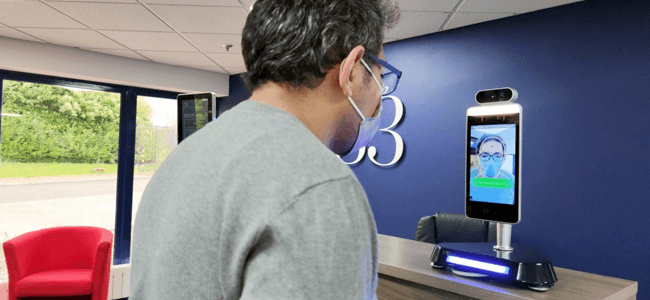
Temperature scanners can be integrated into many types of organizations. While hand-held scanners can be suitable for small offices and for screening individual patients in doctor's offices, since these devices are more physically invasive than kiosks and thermal cameras, they must be more thoroughly disinfected after each use.
Some organizations may benefit from a hybrid approach to temperature scanners. For instance, a doctor's office could use temperature scanning kiosks for patients checking in for an appointment, and then ear or forehead thermometer once a patient is in their appointment.
Since oral thermometers are the most physically invasive and most likely to transmit germs person-to-person, these are best reserved for home use.
Large corporations and schools may benefit from temperature scanning kiosks to quickly screen employees and students as they arrive, while large event venues may use thermal cameras to quickly scan groups of attendees as they enter the building.
As a temperature scanning kiosk distributor, we understand the key differentiators between the types of temperature scanners.
While most temperature scanners are useful in detecting potential illness symptoms, businesses are better suited to certain types in comparison to individuals and households.
If your business is interested in learning more about temperature scanning kiosks, check out our product page here.
Posted by Erica Kastner

Erica Kastner is a lead Marketing Specialist at Standard Office Systems as well as a University of Georgia graduate. She aims to use her passion for problem-solving to help businesses understand how to better leverage their network infrastructure.

